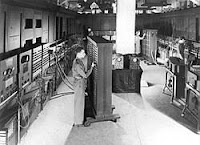First Generation:
First generation computers were manufactured using Vacuum
tubes, electronic relays (As Computer Memory), and punch cards (As input
device). These computers were large in size and difficult for manufacturing.
Some examples of first generation computers:-
ENIAC (Electronic Numerical Integrator and
Calculator), EDVAC (Electronic Discrete Variable Automatic Computer), EDSAC
(Electronic Delay Storage Automatic Computer)
Advantages
- They were the fast device in their time and perform computations in milliseconds
- Vacuum tubes used in manufacturing the first generation computers
- Only Vacuum tube technology was available as an electronic component
Limitations
- Slow speed computational operations
- High Power consumption
- Required large space for installation.
- Too bulky in size
- Highly Unreliable
- Air conditioning required
- Manufacturing/ production was difficult and costly
- Limited commercial use
Second Generation:
Second generations computers were manufactured from Transistors that were the replacement of vacuum tubes used in the first generation. Transistors were smaller and can operate at high speed. Magnetic core, magnetic tapes and disk storage used as computer memory.
The Batch Operating System, high-level programming
language such as COBOL, FORTRAN was the software technologies in the second
generation of computer.
Some examples of Second Generation computers.
Honeywell 400, IBM 1620, IBM 1401, CDC 1604 etc.
Advantages
- Compact in size as compared to first generation of computers.
- More reliable.
- Less heat generated.
- Fast computational speed.
- More stable hardware.
Limitations
- Still used for commercial purposes only.
- Air conditioning required.
- Regular maintenance required.
- Manufacturing/ production was still difficult and costly
Third
Generation :
In third generation, mini computers introduced that
were manufactured from ICs (Integrated Circuits). An IC can be equipped with
many transistors. Larger capacity magnetic core memories used in this generation.
For secondary storage larger capacity magnetic disk and tapes were used.
Time-sharing Operating system, high-level language
such as BASIC (Beginner All-purpose Symbolic Instruction Code) was used during
this period.
Some examples of Third Generation computers.
IBM -360, IBM-370, PDP ,CDC etc.
Advantages
- Smaller in size as compared to previous generations computers
- Even more reliable than previous generations
- High speed computational operations
- Low maintenance cost than the previous generation
- Used for some general purpose
- Less power consumption than previous generation computers
- IC with SSI and MSI technology were used
Limitations
- Air conditioning required in many cases.
- Highly refined technology required for the manufacturing of IC`s
Fourth Generation:
PC`s ( Personal computers) invented in the fourth generation. This generation computer made up of IC with VLSI, microprocessor, larger
capacity hard drive, portable floppy disk drive.
Operating system with (GUI) Graphical user interface,
high-level languages such as C and C++, network-based applications and object
oriented programming concepts were introduced during the fourth generation.
Advantages
- Smallest in size due to VLSI technology
- High speed and very reliable
- More stable hardware
- Easily portable because of their small size
- Also useful for General purpose
Limitations
- Highly refined technology required for the manufacturing of IC`s
Fifth
Generation:
Present computers exist under fifth generations,
these computers are extremely high speed. Apart from this, it can perform
parallel processing. The concept of Artificial intelligence (AI) has been
introduced. It is still in a developmental stage. All the features of the present
computers covered under the fifth generation.
Computer Generations Image gallery (Images Source:- Google)













No comments:
Post a Comment